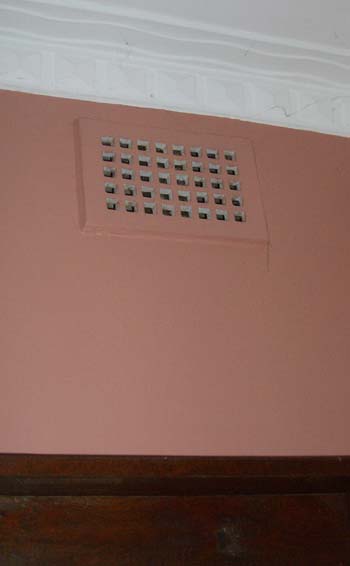
Return to home page
Read May 2007 blog Read April 2007 blog Read March 2007 blog
Read February 2007 blog Read January 2007 blog Read December 2006 blog
Go to my 2001-2 Australia travel book
Send a comment
Other blogs I'm reading: Christine Allen's // Gordon Price's // Sarah Jane's photo site
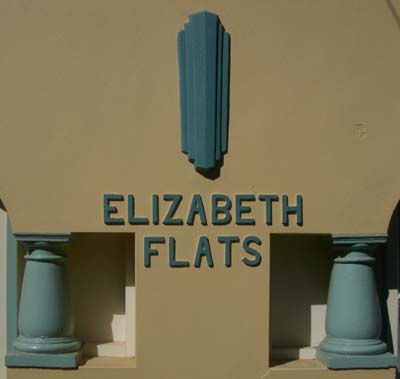 |
We're
living at the Elizabeth Flats, a 1936 art deco triplex in Katoomba,
the largest town in the Blue Mountains west of Sydney. The address is Flat 1, 21 Warialda Street, Katoomba, NSW Australia 2780. There is a separate web page with more pictures of our new home and its surroundings. |
| June 24, 2007: We leave Sydney for Singapore, then back to BC for a month, so the blog is ... well, stay tuned. |
June 23, 2007: The Winter Magic Festival, aka Yulefest, takes place in Katoomba: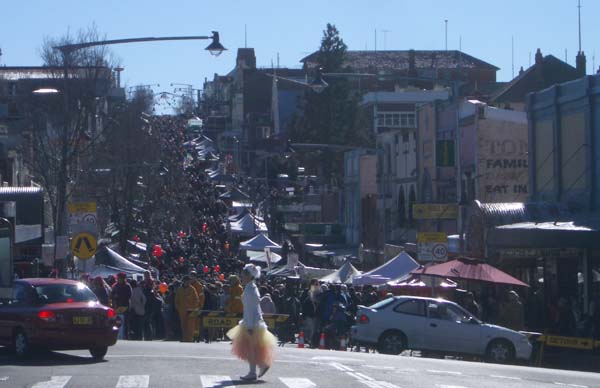 Katoomba Street, with a "snowflake" crossing .... 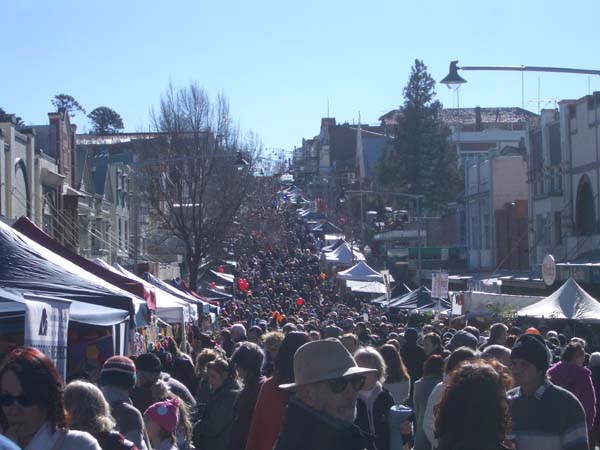 A little further up the street .... 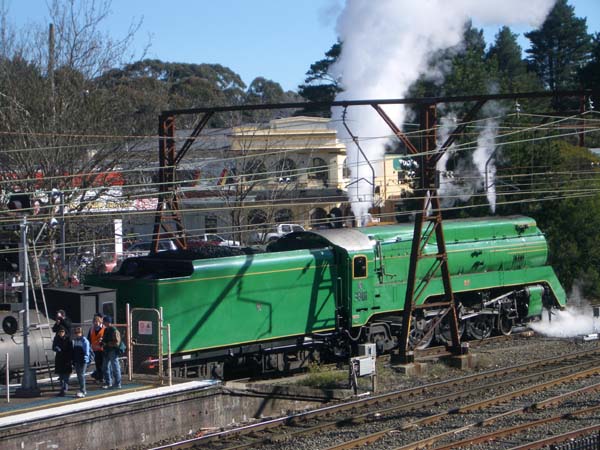 The steam train that came up from the coast, pulling about 20 carriages ..... 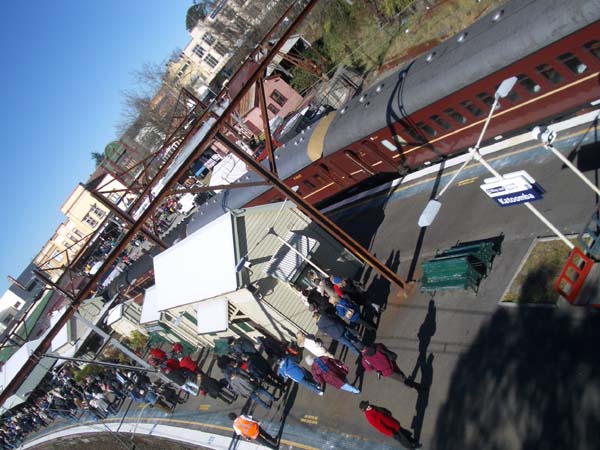 ... packed with people for the winter festival.... 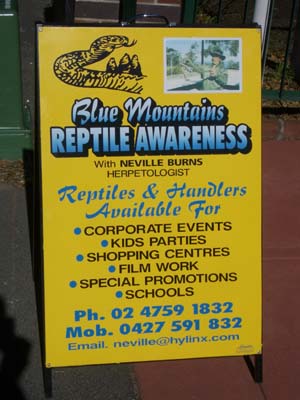 One of the more exotic attractions .... 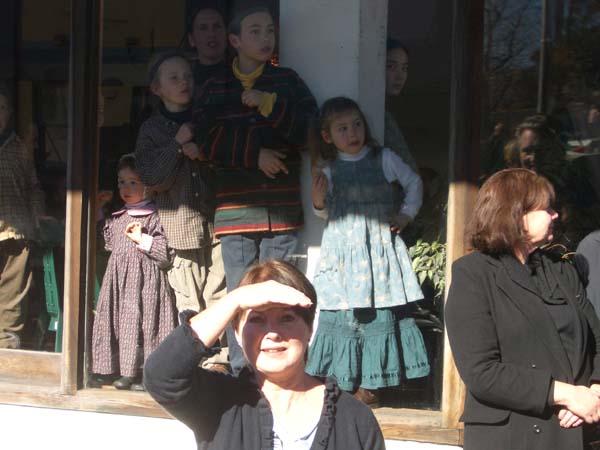 And a few of the people waiting for the parade to start. |
June 20, 2007: Katoomba crippled by snowstorm!!!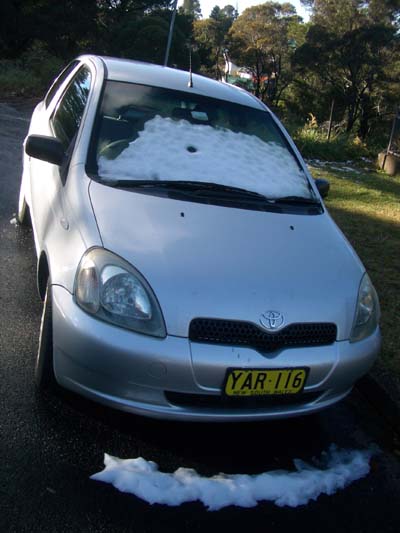 Our Echo, cringing from Nature's onslaught. 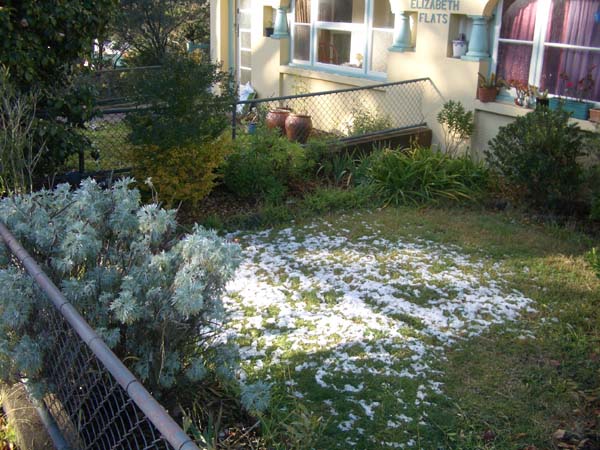 Roland's front yard took the brunt of the snowfall. -there ought to be
more to write
about than the weather, and there is: a Hell's Angel member in
Melbourne shot and killed a Good Samaratin who was attempting to stop
him dragging a stripper into his car, this at 8 in the morning,
refuelling the debate over whether police should crack down on "bikie
gangs," as they're called here, and further tighten firearms laws; the
Coalition is slowly gaining ground on Labour as it continues to crib
Labour's popular proposals, etc. etc. But it's the weather that's
making the news.
We awoke this morning to a radio report that the Great Western Highway had been "blocked" by about 6 inches of snow at Wentworth Falls, about 10 km east, and was similarly impassable west of here. School principals were advising parents to think about safety before sending their children off .... But from here, it's a bit of a non-event. However, the cyclone-force winds and torrential rains along the coast really made the news. Sydney has been swamped with more than 450 mm. of rain this month -- now it's the wettest June since 1950. And the freighter on the beach at Newcastle (photo on June 9) is still there, as the weather's been too rough to commence the salvage operation. Weird weather. We've had 340 mm. of rain in the past 12 days. That's 1/4 of our annual dose. Christine's sister Caroline sent along a Powerpoint slide show (a .pps file, 1.8 mb) of the storm damage at Newcastle. The freighter pictures at the end are spectactular. Hope it works on your computer! |
| June 17, 2007: For
the second weekend in a row, the New South Wales coast has been lashed
by storms and drenched. Sydney has had the wettest June since 1964, and
the month is only half over. The city had 180 mm. of rain (7 inches) in
the past couple of days -- we had 100 mm, and all the dams in the Blue
Mountains Catchment are nearly full! Drought, what drought? Anybody who's visited Sydney has probably taken the Manly ferry, a large ship whose crossing of the harbour takes it across the heads where it's exposed to the ocean swell. The helicopter pictures on the tellie were really dramatic, with waves breaking over the ship's bow and it pitching and rolling like the proverbial cork. And then there was the interview with a resident of an apartment building on the beach at Collaroy. Instead of a beach in front of his building, there was a four-metre bluff. But he was philosophical about it : he figured the waves had created a sandbar a hundred metres offshore which would improve the surfing conditions. |
| June 11, 2007: The
storm has long passed. It's back to cloudless skies here. But the flood
waters are just arriving in Newcastle, on the coast north of Sydney,
having failed to breach the 50-year-old levee at Maitland in the Hunter
Valley. The most ironic story on the news over the past few days,
though insignificant compared to the wreckage and loss of life,
concerned a young woman interviewed in the blowing rain in Newcastle on
Saturday. Her car had been trashed by hail in a storm a few years ago,
she told the reporter, so she thought it would be safer in an
underground parking garage.... The camera then rolls focus to the
garage, where only the rooftops of a few cars are visible above the
muddy water. Our rainfall totals in Katoomba were, according to the BOM site (Bureau of Metereology), were 200 mm., about 8 inches, over the Thursday-Saturday period. The roof doesn't leak, but a lot of the windows, including the leadlights, need caulking. We were talking with a Queensland acquaintance in Sydney yesterday about the "Toads for Beer" bounty mentioned below. The rate was 10 toads for a can of beer. He said, "They don't know Queenslanders -- someone will figure out it's easier to breed them." |
June 9 (late at night), 2007: 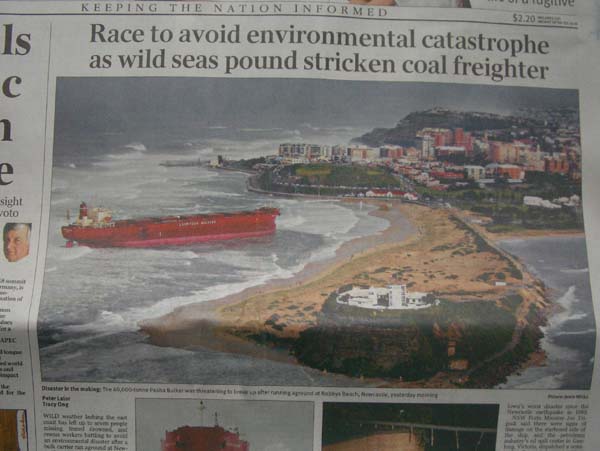 The front page of today's Australian The storm has become
worse during
the day, not for us, but 100 km. away along the coast the situation is
dire. Apparently the tanker will not break up, which is good news, but
sections of the famous wine-growing Hunter Valley are being evacuated
after, for example, 190 mm. of rain in Cessnock. Seven people are dead
and one is missing, presumed dead, after washouts and flash floods.
Nevertheless, the TV newscasts contain more than weather disasters. Two items from the ABC: -in the Top End, aka The Big Wet way up north in the tropics, cooler weather has caused the temporary cancellation of the "Beer for Toads" bounty campaign. Locals have been encouraged to capture the invasive, horrid cane toads and turn them in. The bounty is beer (I missed how many toads per stubby) or, if you're a child, a scoop of ice cream per toad. Next week, the item will be about obese children and drink-driving in the cane-toad areas of Northern Queensland. -the passing of Lynne Rendell, the first teen pop star in Australia, was noted. Her breakthrough hit was "Ciao Baby" in 1967. "Never heard of her," muttered Christine, who left Australia for the first time in 1969. Rendell requested a party instead of a funeral. |
| June 6, 2007: On
the same day as the weird "Faith Politics" confessional of Democratic
candidates in the USA, which was widely reported here, Cardinal Pell of
New South Wales warned Catholic state politicians here that they might
be denied communion if they voted for stem-cell research. Some
commentators noted that if the Muslim mufti of Australia, a very
controversial character indeed, had entered the political arena on such
an issue he would be booted out of the country. One politician called
Pell "a serial bullhead." A horrendous train crash in northwestern Victoria, about 1000 km. from here, has killed 11. Apparently a semi-trailer driver ran into the train at a level crossing whose warning bells and lights were functioning. The pictures are so gross they've probably made the North American TV news. It comes to mind because we were basically run off the road by a truck passing another on the two-lane Newell Highway, about 300 km from the crash site, a week ago. Christine's aunt and uncle won't use the Newell, we subsequently learned, because of the truckers. Needless to say, when you travel through the area you see that the highways are crowded with trucks while the excellent rail network sits rusting and almost unused. |
| June 5, 2007: Two
recent items about women in politics, following the "entrenched
blokiness" event recorded on May 22. In one, a minor cabinet minister
in the federal Coalition government announced she would not seek
reelection because of the stress it was causing on her young family.
Children need a routine, she said, and there is nothing less routine
than a political life. No controversy there. The other involved the wife of the "prime minister in waiting," the Labour leader of the opposition, Kevin Rudd. Her name is Therese Rein, and over the past 25 years she has built from scratch a multinational employment-placement business that generates $170 million revenue a year. But a group of her Australian employees turned out to have been disadvantaged aka underpaid when she used the Coalition government's very controversial industrial relations laws, which her husband has vowed to eliminate once elected, to negotiate contracts with them. In the uproar, it quickly became clear that she couldn't continue to own the Australian branch of her company, as it has done many millions of business each year with the federal government. So she has announced she will sell it, while keeping her overseas offices. So far so good, but her normally teflon-coated husband managed to deepen the scrap when he spoke admiringly of his wife as "not a mere appendage of a middle-aged man." The appendages and their husbands, led by the prime minister, duly took umbrage. The Coalition was up 5% in the polls reported on the weekend. Further evidence of the Australian character appeared on the ABC today, on the Sydney morning radio program. The perfect barbecued hamburger was the topic, an odd choice given that it's winter-cold this week. Raw onion mixed into the patty was considered to be rude to guests, who might get indigestion, but fried onion as an optional filling was okay. Pineapple could be eaten or rejected, as could a fried egg, but it was considered un-Australian to reject the beetroot. All Australian burgers have a slice of pickled beet on them, always referred to as "beetroot." |
June 2, 2007: back
home again after a week away. A few bits from the trip: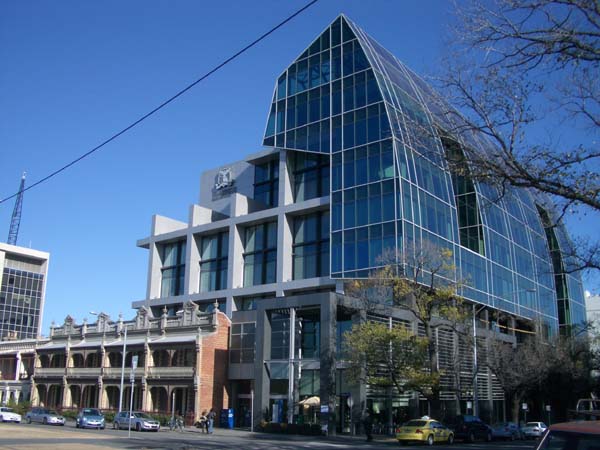 A farewell morning in Melbourne. We had breakfast in the unbelievably vibrant restaurant strip on Lygon Street in Carlton, then walked with cousin Ray Ison through the University of Melbourne, where he works. The photo shows something of the contrast between the old Melbourne and the new, in this case a library of the university. Drove east from Melbourne, many of whose 4 million citizens live in dream homes, of red brick, picture window and staring red-tile roof on flat sterile block, that stretch forever into the eucalptus bush. Eventually arrived in the fertile Gippsland, a rolling landscape preoccupied with dairying, with the foothills of the Australian Alps standing to the north. Amazingly green after the autumn rains. At the southeastern corner of the continent, bordering the Tasman Sea, the road descends to the coast through a series of sandbars and lakes where a relatively small river opens out to the Tasman Sea. Lakes Entrance is the fishing and tourist town that occupies the ocean shore; the main crop appears to be gummy shark, which is caught in the shallows and served with batter and chips at several shops along the Esplanade. We checked into a delightful motel on the narrow isthmus between lake and ocean beach, then went looking for a place to eat. The Bowls Club (i.e. lawn bowling) was the best choice, with "flake and chips" (i.e. shark) and $10/ carafe chardonnay in the dining room and adjoining rooms full of "pokies" (i.e. variations on slot machines and video gaming terminals) that occupied members and visitors both pre- and post-dinner, or instead of it perhaps. Thriving clubs like this are features of most country towns; most are RSL (i.e. returned servicemen's leagues, the same as the Legion), others are affiliated with supposedly non-profit enterprises like lawn bowling or rugby league. Most diners are really large, due to the really large dinners. Obesity is a problem throughout Australia, declining as one approaches the centres of cosmopolitan cities, as it is in North America. It's dark and almost winter. The sidewalks are rolled up. We go back to the motel and turn on the TV, which comes on at Ten (one of 6 available channels), a program called Biggest Losers. Why are they losers? It's so hard to tell these days. Turns out it's two couples competing to see which can lose the most weight and win a $50,000 dream wedding. Was disappointed to see/hear that it was an American program from LA; figures. Nevertheless, thought it was morally uplifting and it could have been an Australian show, featuring younger versions of the people in the Bowls Club. Next day drove north up the Princes Highway, back into New South Wales. The road stays a long distance inland and travels through forests and fields in a rather uninspiring way, looping occasionally out to the coast. Decided to cut inland and take the Snowy Mountains Highway directly to Canberra. We travelled through a landscape that could have been BC's interior -- very dramatic, dry and shivering in the twilight of the first day of winter, June 1st. 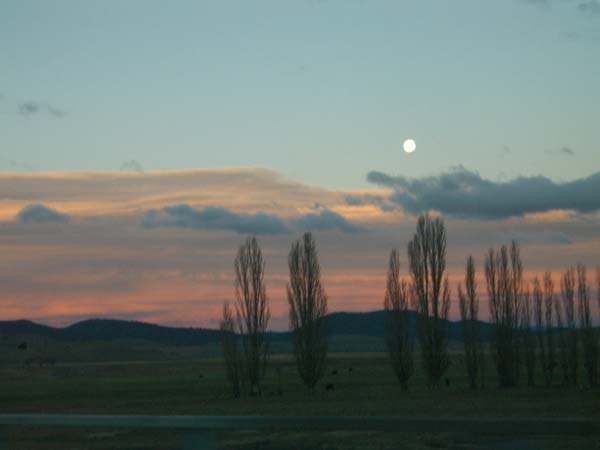 Canberra: art stop
#2, for the landmark exhibition on Australian
printmaking.
We both noticed how many women artists were represented in the
exhibition, compared with the Melbourne Impressionist one. Oil painting
was a manly task, it seems, whereas many of the
printmaking stars were women like Margaret Preston. Women learned to
draw and paint watercolour, and some added the "accomplishment" of
printmaking to their roster of talents. Saw a bumper sticker, "Real Men
Don't Paint Watercolour," on the back of a ute out in the countryside,
although I may have been mistaken.
And a final couple of photos that bracketed the trip. Australia has something of a reputation for installing huge roadside sculptures such as The Giant Pineapple at Coff's Harbour, big bananas and so on. Barry Humphries, better known to the world as Dame Edna Everage, wrote a book 25 years ago called "A Treasury of Australian Kitsch" which recorded a few of them. On a more serious (and annoyed) note, architect Robin Boyd wrote "The Great Australian Ugliness," concentrating on suburban design but making reference to roadside objects, too. 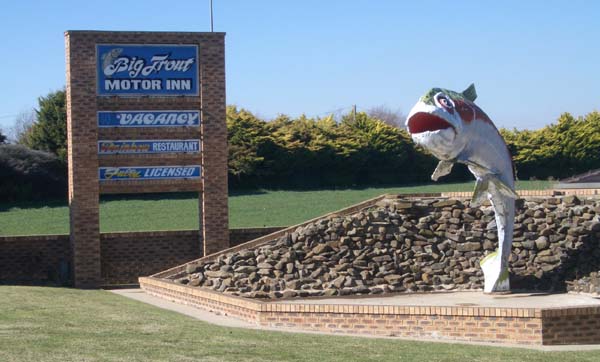 The big trout in Oberon, just west of us in the Blue Mountains, isn't really all that big, but .... 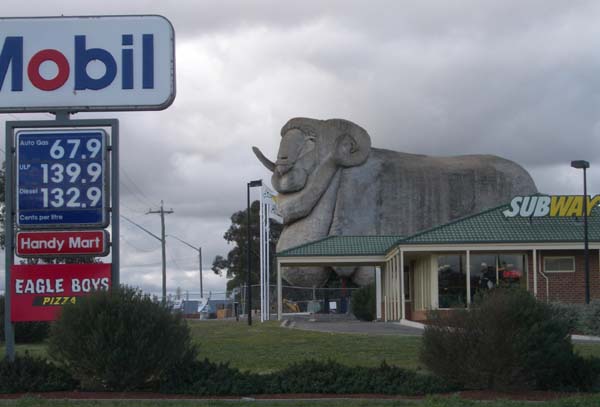 The
Giant Merino in Goulburn, a big country town north of Canberra, is
truly a landmark. It used to sit atop the tourist info centre and gift
shop on the highway into town, but it became marooned when a highway
bypass was completed. Patriotic, entrepreneurial Aussies moved it a few
weeks ago, at a reported cost of $400,000, to the site of a new petrol
station at the main freeway exit. Note the world-class
businesses which share the street with it, and also the petrol prices
(ULP = unleaded petrol, of course). The government's
competition bureau has declared itself powerless to roll back the
recent 10+ cents a litre jump all over Australia, at every station.
There was also the Giant Strawberry, somewhere in the Murray region of
Victoria, but it didn't seem all that big so I didn't take a picture.
|
